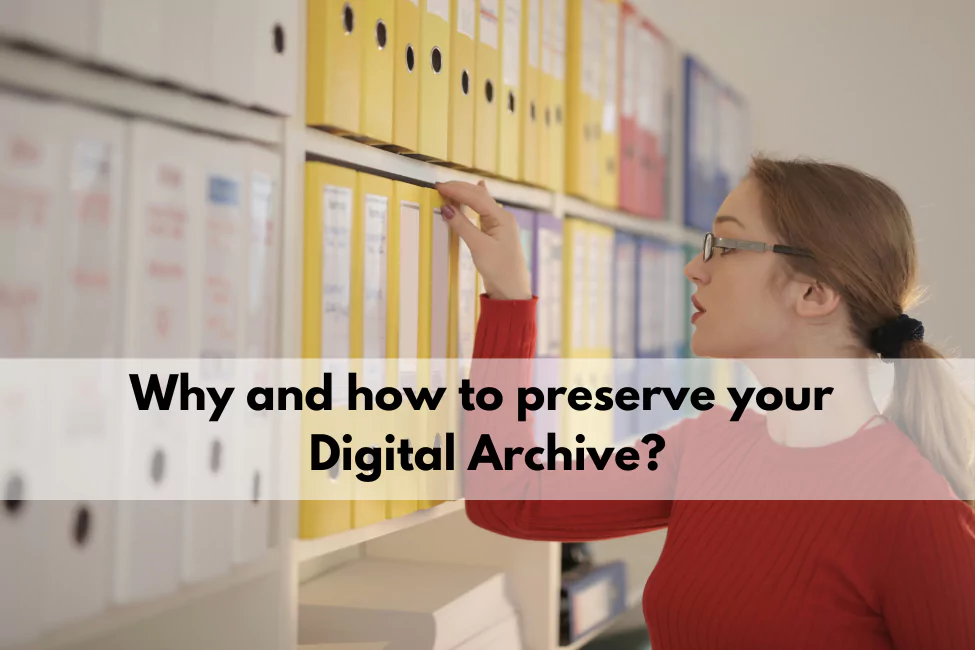The volume of digital information is increasing at warp-time speed. Whether created as a result of the digitising of non-digital collections, as a digital publication or artwork, or as an inherent part of the day-to-day business of an organisation or individual, more and more information is being created digitally and the pace at which it is being created is accelerating.
And this is perfectly understandable considering the well-known benefits and opportunities of digital information: precise replication, machine processing, online content, … And yet at the same time this rapidly increasing collection of digital information introduces hordes of difficulties with regard to the viability of these digital documents and the long-term accessibility to the valuable information stored in all these documents. The life span of digital storage media can be surprisingly short, and the rapid evolution of rendering software technology can threaten future access. This life span problem means that planning needs to go into how to preserve your digital archive.
Digital archiving solution
As an organization in the public or private sector, you probably have digital records and information that you need to keep for long periods of time. If that information is important enough for you to preserve, you should enable yourself to access it in the future. By implementing a digital preservation strategy and following a clear preservation planning you make sure that all your valuable digital documents will remain findable, accessible and useable regardless of your company’s future hardware and software systems.
Open Archival Information System (OAIS)
The Open Archival Information System (OAIS) Reference Model (ISO 14721:2012) is a conceptual framework for an archival system dedicated to preserving and maintaining access to digital information over the long term. This Model was originally developed by the Consultative Committee for Space Data Systems as a reference model for an OAIS for space agencies, but has proved to be useful to a wide variety of organizations and institutions with digital archiving and digital preservation needs.
PDF/A: the ultimate archiving file format?
An important aspect of your digital archive and preservation strategy is the file format you use for your digitally archived documents.
In an earlier post “6 good reasons for converting to PDF” we elaborated on the benefits of the PDF file format and why it has become the standard for the exchange and storage of data. PDF files may be created natively in PDF form, converted from other electronic formats, or digitized from paper, microform or other hard copy format. Once created, the files must remain useable and accessible across multiple generations of technology. This is where PDF/A comes in.
The PDF/A file format enables organizations to archive documents electronically in a way that will ensure the preservation of content and visual appearance over an extended period of time. It also allows documents to be retrieved and rendered with a consistent and predictable result in the future, independent of the tools and systems used for creating, storing and rendering the files.
PDF/A distinguishes itself due to the following characteristics:
-
Independent
A PDF/A contains all necessary information to render the document exactly like it was originally created. A PDF/A contains all information about the text, pictures, graphics, font types and colouring information. References to external sources is not required. They may not even exist any more by the time the archiving document is accessed.
-
Self-descriptive
PDF/A supports metadata descriptions. By adding metadata to your archiving document it is very easy to understand what this document is about.
-
Universal
With PDF/A you do not require multiple special applications to open and view files. A single application is all you need for viewing electronic documents from any source.
It is undeniable that PDF/A is an excellent file format for archiving purposes, but it is not the only format that is well suited to preserve your valuable electronic documents for the future.
DocShifter simplifies your digital preservation by converting your content into future-proof file formats
At DocShifter we understand the importance of digital preservation and have come up with a digital archiving solution. We have added several preservation functionalities to our platform. It is a server based solution that allows you to convert any source format to any other format.
DocShifter can generate an entire series of recommended target archiving formats (PDF/A-1b, TIFF, JPEG etc.) that can be employed in the context of an OASIS repository.
With the DocShifter document conversion software, you can easily:
- Archive a valuable electronic document by creating an archived document version in the file format of your choice
- Convert your existing archived documents of any file format to archived documents of any other file format.
- Set up an OAIS Trusted Repository.
Another strong feature of DocShifter is that it works independent of the native applications of source- and goal file formats. So you do not have to worry about the costs of expensive software tools and licenses.
This is the perfect solution for everyone who is confronted with obligations of digital archiving and long-term storage of digital information, like archivists, Web developers and Integrators of DMS or IM solutions.
About DocShifter
Speed, quality, scalability, and configurability are reasons why many organizations in regulated industries (life sciences, banking & insurance) choose DocShifter. Convert your content into PDF/A, TIFF and other archiving formats for your digital archive.
High volume, high-quality document conversion, on-premise, or in the cloud. Super easy to set up. Automate. Centralize. Eliminate manual intervention. Reduce Risk. Reduce IT infrastructure costs. Rated 5 stars on Gartner’s Capterra platform.
Last update: 08/01/2021



